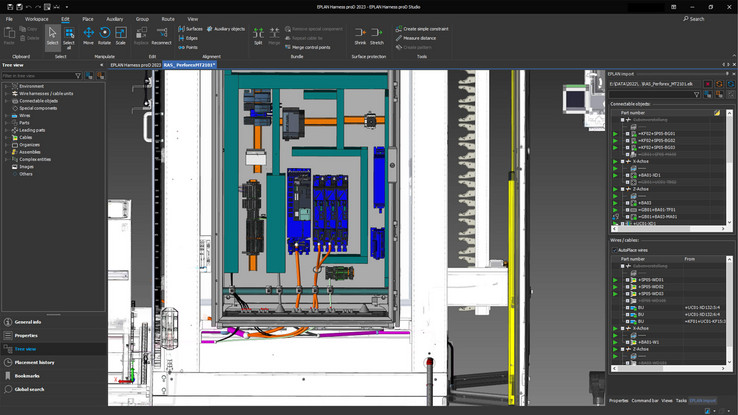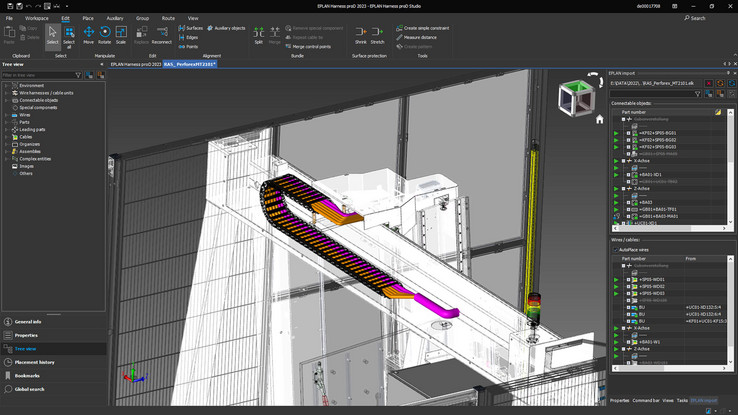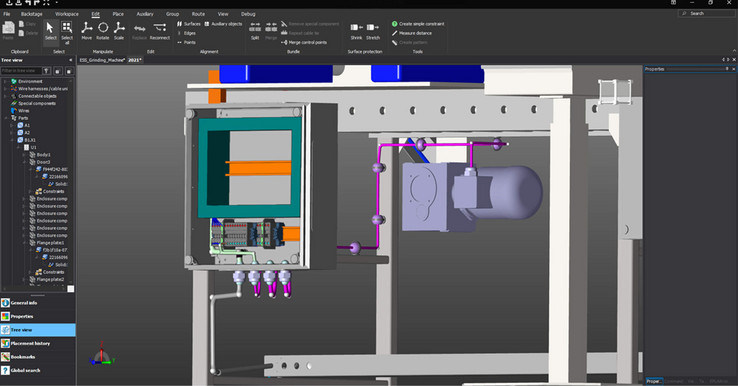Machine Cabling? Now Based on the Digital Twin!
EPLAN Harness proD has now been expanded with machine cabling in mind
Unknown cable lengths are a major cost driver in machine building. Whether designed too short or too long, any miscalculations directly affect the costs of a machine. Up until now, field cabling has usually been accomplished through trial and error. EPLAN Harness proD software – previously widely used for creating wire harnesses – has now been expanded with machine cabling in mind.
Finding the right cabling, designing it and displaying the routing for assembly? Up until now, this has been a fairly laborious process for electrical engineers in machine building. Servo drives or sensors/actuators (M8s/M12s for instance) are offered by different suppliers in various configurations. Aside from the actual surrounding conditions, the mechanical, chemical and electrical properties must also be taken into account. All of this information remains incomplete, however, until the required length of cable is determined. If the eyeball-estimate for a cable ends up being too long, the excess cable is usually stowed in looped coils beneath the control cabinet or machine. The problem with this is that such storage may not comply with the specifications for EMV and bending radii, increasing the risk of malfunctions and time-consuming troubleshooting. Shortening the cable requires time-consuming and error-prone manual assembly, since the cable usually terminates in elaborate connectors and numerous contacts. Replacing it can also end up being a lengthy and expensive process. It’s much better to plan and design with precise data beforehand, for instance based on the digital twin.
Electrical and mechanical engineering working hand in hand
This is exactly where solutions provider EPLAN comes in. We listened to the needs of the market and expanded the 3D software EPLAN Harness proD to meet the practical requirements for machine cabling in the real world. What has long been standard operating procedure for devices and mobile machines is now also being used in electrical engineering – the digital twin of the cabling. Depicted in Harness proD, it combines electrical and mechanical engineering to provide a clear, consistent source of product data – for manufacturing as well as assembly and servicing. The common parts database for the EPLAN systems ensures a precise data source.
Effective design from every discipline
For machines and vehicles, the individual cables are bundled, manufacturing documentation is derived and the actual wire harness is then manufactured – which is always unique and precisely tailored to the respective device or mobile machine. Here, mostly unidirectional or completely preassembled cables are used. Mass-produced cable (sold by the meter) may also be utilised. The digital 3D model of the control cabinet structure in EPLAN Pro Panel is the starting point for all cabling. Additional field components, designed in EPLAN Electric P8, can very easily be integrated into the 3D mechanical model and installed. A clear practical advantage is that each discipline retains its own view of the machine – mechanical engineers continue to think in terms of assemblies, electrical engineers in terms of functions.
Uniform device data
The process for cable design is very simple. Electrical engineers use EPLAN Electric P8 to design the cables required in the schematics. They also define, almost in passing, the devices required for the cabling designs in EPLAN Harness proD. This is where the decisive advantage of the process becomes apparent: the common device database for the EPLAN systems. Everything is based on a single source, meaning there is no chance of errors creeping in! The electrotechnical project is then linked to Harness proD, and the 3D geometries of the mechanics are imported into the cabling tool. With this information, the external equipment is positioned in the 3D environment, cable paths are defined by the system, and the cables are subsequently routed. Once all the equipment and cables have been added, the designers receive a digital twin of all the cabling. This twin now has a dual impact: it can be made available to the mechanical design team as a 3D assembly or transferred into the electrical engineering project with the supplemental cable information.
An overview of everything – even at the earliest stages
What the traditional way of working only revealed with the initial physical prototype becomes clearly visible much earlier using this integrative process. Any changes made, for instance during the prototype phase, can be accomplished with just a few clicks on the keyboard. An actual physical counterpart in the factory or the workshop is no longer necessary. The digital twin is the medium for full collaboration in engineering, or for starting constructive conversations with clients – whether during the specification phase, the development phase for design checks, or even for marketing purposes. Taking this digitalisation even further, it could also be used as a data source for implementing augmented reality strategies.
Innovations in EPLAN Harness proD 2023
With the most current version of EPLAN Harness proD, users now have access to all devices in the Electrotechnology category of the EPLAN Platform device management system. Data from motors, plugs, cables, etc. are fully available. The central viewing of devicesfacilitates the maintenance of master data. For instance, if a control cabinet assembly is integrated into the machine from EPLAN Pro Panel, all the components and their connection information can also be transferred, forming a precise starting point for field cabling.
Mechanical engineers often design the cable routing using cable ducts, cable trays and energy chains. Version 2023 now also makes it possible to use cable ducts, energy chains and cable traysfor cable routing. Even if it is the mechanical engineer who does the planning, the electrical designer now knows exactly whether the cables will fit through the intended pathways and which exact lengths are required. Another practical feature is that the cables can be directly connected, since the information is already stored in the schematics.
Added Value for Customers
- Complete EPLAN Project (single source of truth)
- Transferring the digital twin to mechanical engineering
- Complete bills of materials, including cable lengths for the electrical design
- Cable assembly drawings for special pre-processed cables in production
- 3D HTML viewer for assembly and maintenance
Author: Michael Widmann, Business Development Manager at EPLAN





